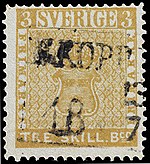| Treskilling Yellow | |
|---|---|
 | |
| Country of production | Sweden |
| Location of production | |
| Date of production | 1855 |
| Nature of rarity | Color error |
| Estimated existence | 1 |
| Face value | 3 Skillings |
| Estimated value | CHF 2,500,000 = US $ 2,060,000 (last sale, 1996) The "Treskilling" Yellow, or 3 skilling banco error of color (Swedish: Gul tre skilling banco, Gul=yellow), is a postage stamp of Sweden, and holds the world's record auction sales price for a single postage stamp. In 1855, Sweden issued its first postage stamps, a set of five depicting the Swedish coat of arms, with denominations ranging from 3 to 24 skillings banco. The 3-skilling banco value was normally printed in a blue-green color, while the 8-skilling was printed in a yellowish orange shade. It is not known exactly what went wrong, but the most likely explanation is that a cliché of the 8-skilling printing plate (which consisted of 100 clichés assembled into a 10 x 10 array) was damaged or broken, and mistakenly replaced with a 3-skilling cliché. The number of stamps printed in the wrong color is unknown. Somehow, this error went entirely unnoticed at the time, and by 1858 the currency was changed. The skilling stamps were replaced by new stamps denominated in öre. In 1886, a young collector named Georg Wilhelm Backman was going through covers in his grandmother's attic, and came across one with a 3-skilling stamp, for which local dealer Heinrich Lichtenstein was offering 7 kronor apiece. After changing hands several times, Sigmund Friedl sold it to Philipp von Ferrary in 1894, who had at that time the largest known stamp collection in the world, and paid the breathtaking sum of 4,000 gulden. As time passed, and no other "yellows" surfaced despite energetic searching, it became clear that the stamp was not only rare, but quite possibly the only surviving example. When Ferrary's collection was auctioned in the 1920s, Swedish Baron Eric Leijonhufvud acquired the Yellow, then Claes A. Tamm bought it in 1926 for £1,500 (GBP) in order to complete his collection of Sweden. In 1928, the stamp was sold to lawyer Johan Ramberg for £2,000 who had it for nine years. In 1937, King Carol II of Romania purchased it from London auction house H. R. Harmer for £5,000, and in 1950 it went to Rene Berlingen for an unknown sum. In the 1970s, the Swedish Postal Museum caused controversy by declaring the stamp to be a forgery, but after examination by two different commissions, it was agreed that it was a genuine error. In 1984 the stamp made headlines when it was sold by David Feldman for 977,500 Swiss francs. A 1990 sale realized over one million US dollars, then in 1996 it sold again for 2,500,000 Swiss francs. Each successive sale has produced a world record price for a postage stamp. |
DEFİNE-DEFİNECİLİK-DEFİNE İŞARETLERİ-DEFİNE İŞARET ÇÖZÜMLERİ-DEFİNE HARİTALARI-DEFİNEYOLU-DEDEKTÖR-CİN-BÜYÜ-DEFİNE ARAMA ÇUBUKLARI YAPIMI-MADENLER-TILSIM-GÖMÜ-EŞKİYA BELGELERİ-DEFİNEYERİ-HÖYÜK-TÜMÜLÜS-EŞKİYALAR-DEFİNEGİZEMİ-ARKEOLOJİ-TARİHTE PARA-TAKILAR-DOĞAL TAŞLAR-MÜZELER-İSLAM-DEFİNE HABERLERİ-MİTOLOJİ-HEYKEL-ANTİKA-ARKEOLOJİ-ANTİK BÖLGELER-ANTİK KENTLER-HORASAN-TİCARET YOLLARI-EBCED-İŞARET ÇÖZÜMLERİ-DEFİNE ARAMA-ROMA-BİZANS-GREEK SİKKELERİ SADECE DEFİNETUTKUNLARINDA ÖĞRENİLİR